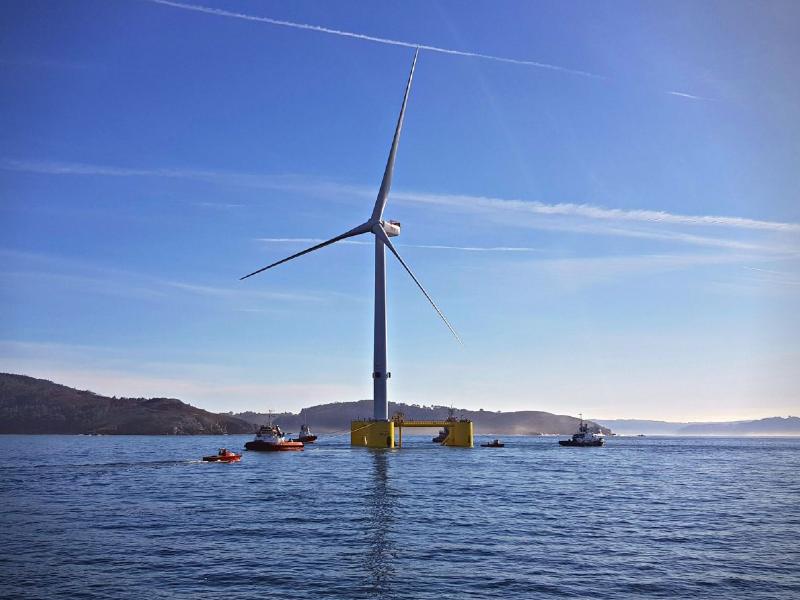 Image credit: Global Wind Energy Council
Image credit: Global Wind Energy Council
In the US, several federal agencies have launched actions intended to develop new floating offshore wind platforms.
White House National Climate Advisor Gina McCarthy, Energy Secretary Jennifer Granholm, and Interior Secretary Deb Haaland announced what is being labeled as the New Floating Offshore Wind Shot. The Wind Shot has a goal of lowering costs by 70% by 2035. The initiative aims to speed up breakthroughs across engineering, manufacturing, and other innovation areas to reduce the costs of floating technologies to $45/MWh.
A White House statement said that conventional offshore wind turbines can be secured directly to the sea floor in shallow waters near the East Coast and the Gulf of Mexico. But, deep-water areas that require floating platforms are home to two-thirds of America’s offshore wind energy potential, including along the West Coast and in the Gulf of Maine.
As part of the effort to expand offshore wind deployment, the federal government will advance lease areas in deep waters in order to deploy 15 GW of floating offshore wind capacity by 2035. That would add to its existing goal of deploying 30 GW of offshore wind by 2030. That goal largely would be met using fixed-bottom technology.
To advance the goals, the Biden Administration launched a new prize competition for floating offshore wind platform technologies; initiatives funded by the Bipartisan Infrastructure Law to develop modeling tools for project design and to analyze port needs; and other funding for research, development, and demonstration efforts. And the recently enacted Inflation Reduction Act offers clean energy tax credits to support domestic wind turbine blades, fixed-bottom and floating platforms, and installation vessels, among other things.
The Floating Offshore Wind Shot is led by the Departments of Energy (DOE), Interior (DOI), Commerce, and Transportation. DOE and the National Science Foundation will also collaborate on research and workforce development.
The DOI’s Bureau of Ocean Energy Management (BOEM) will advance lease areas in deep waters for floating technology, starting with a lease auction off the coast of California by the end of 2022.
DOE announced nearly $50 million—including support from the Bipartisan Infrastructure Law—for research, development, and demonstration funding. Among the initiatives is a Floating Offshore Wind Readiness Prize. The $6.85 million prize competition targets competitors who will work to optimize floating platform technologies and get them ready for wide-scale domestic manufacturing and commercialization.
DOE also announced a $3 million project funded by the Bipartisan Infrastructure Law to develop a set of modeling tools to help industry and researchers design commercial-scale floating offshore wind farm arrays in U.S. waters, including their anchors, mooring lines, and subsea power cables.
In addition, a nearly $1 million project funded by the Bipartisan Infrastructure Law would be used to reduce infrastructure challenges by outlining a network of West Coast ports and upgrades needed to deploy commercial-scale floating wind. DOE announced an analysis to review existing transmission studies and identify research gaps related to offshore wind integration in California, Oregon, and Washington. This work is expected to help support future analysis that will aid in transmission planning and buildout.
DOE’s Advanced Research Projects Agency-Energy (ARPA-E) intends to announce $31 million in funding through phase two of its Aerodynamic Turbines, Lighter and Afloat, with Nautical Technologies and Integrated Servo-control (ATLANTIS) program. The program focuses on novel forms of systems engineering for floating offshore wind systems to drive down costs. This second phase will focus on experimental testing in ocean, lake, and tank and tunnel environments to further develop new technology for floating offshore wind turbines.
DOE and BOEM also announced a $1.6 million project to support coexistence of floating offshore wind with bats on the West Coast of the United States.
The National Offshore Wind R&D Consortium, a partnership established with funding from DOE and the New York State Energy Research and Development Authority (NYSERDA), announced five projects totaling $3.5 million to facilitate ocean area coexistence with marine mammals and fishing and to support offshore wind transmission for both fixed-bottom and floating technologies.
The White House said the collection of actions will position the U.S. to lead the world on floating offshore wind technology. It said that globally, around 0.1 GW of floating offshore wind has been deployed to date, compared with over 50 GW of fixed-bottom offshore wind.
